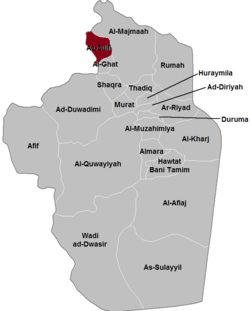
Riyadh is the capital and largest city of Saudi Arabia. It is also the capital of the Riyadh Province and the centre of the Riyadh Governorate. The current form of the metropolis emerged as an offshoot of the eponymous walled town following the dismantling of its defensive fortifications in the 1950s, after which the city underwent several phases of expansion and urbanization.

Najd is the central region of Saudi Arabia, in which about a third of the country's modern population resides. It is the home of the House of Saud, from which it pursued unification with Hejaz since the time of the Emirate of Diriyah.
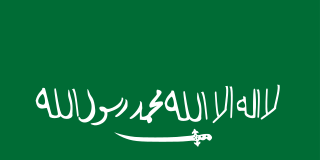
The Ikhwan, commonly known as Ikhwan man ata'a Allah, was a Wahhabi religious militia made up of traditionally nomadic tribesmen which formed a significant military force of the ruler Ibn Saud and played an important role in establishing him as ruler of most of the Arabian Peninsula in the unified Kingdom of Saudi Arabia.

The Emirate of Nejd or Imamate of Nejd, also known as the second Saudi state was existing between 1824 and 1891 in Nejd, the regions of Riyadh and Ha'il of what is now Saudi Arabia. Saudi rule was restored to central and eastern Arabia after the Emirate of Diriyah, the first Saudi state, having previously been brought down by the Ottoman Empire's Egypt Eyalet in the Ottoman–Wahhabi War (1811–1818).

Saud Al Kabeer bin Abdulaziz Al Saud was a grandson of Saud bin Faisal bin Turki and a distant nephew and important supporter of King Abdulaziz, founder of Saudi Arabia. Prince Saud was one of the most known Najdi people. Through his marriages he was the brother-in-law, and later a son-in-law, of King Abdulaziz. Saud was married for 45 years to King Abdulaziz's eldest sister Noura bint Abdul Rahman, and after her death in 1950 he married the King's daughter Princess Hessa.
Al-Mutairi is an Arab tribe with origins in the northern Hejaz near Medina, in present day Saudi Arabia. The tribe mainly inhabits Saudi Arabia (Najd), Kuwait, Iraq, and the United Arab Emirates. They have also settled in Morocco and Tunisia.
The Otaibah is one of the biggest Arab tribes originating in the Arabian Peninsula. Their distribution spans throughout Saudi Arabia, especially in Najd. and the Middle East. The Otaibah are descended from the Bedouin. They trace back to the Mudar family and belong to the Qays ʿAylān confederacy through its previous name, Hawazin.

Manfuha is an ancient village and a historic neighborhood in southern Riyadh, Saudi Arabia, located north of al-Masani and south of Skirina in the sub-municipality of al-Batʼha. Established on the edge of the narrow, fertile valley known as Wadi Hanifa, Manfuha was until the mid-20th century considered a twin village to the walled town of Riyadh, the current Saudi capital.
Banu Hanifa is an ancient Arab tribe inhabiting the area of al-Yamama in the central region of modern-day Saudi Arabia. The tribe belongs to the great Rabi'ah branch of North Arabian tribes, which also included Abdul Qays, Taghlib, al-Nammir ibn Qasit, and Anazzah. Though counted by the classical Arab genealogists as a Christian branch of Bani Bakr, they led an independent existence prior to Islam. The ruling House of Saud of Saudi Arabia belongs to it.
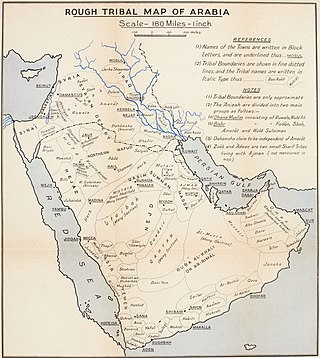
Anizah or Anazah is an Arabian tribe in the Arabian Peninsula, Upper Mesopotamia, and the Levant.

The Unification of Saudi Arabia was a military and political campaign in which the various tribes, sheikhdoms, city-states, emirates, and kingdoms of most of the central Arabian Peninsula were conquered by the House of Saud, or Al Saud. Unification started in 1902 and continued until 1932, when the Kingdom of Saudi Arabia was proclaimed under the leadership of Abdulaziz, known in the West as Ibn Saud, creating what is sometimes referred to as the Third Saudi State, to differentiate it from the Emirate of Diriyah, the First Saudi State and the Emirate of Nejd, the Second Saudi State, also House of Saud states.
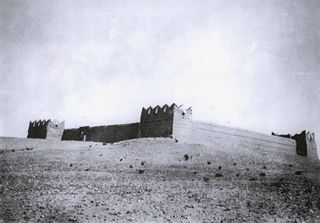
The Battle of Jahra occurred on 10 October 1920 during the Kuwait–Najd War, pitting Sheikh Salem Al-Mubarak Al-Sabah, the ruler of Kuwait, against the Ikhwan forces led by Faisal al-Duwaish, the sheikh of the Mutayr tribe. The confrontation took place in the village of Al-Jahra, located west of Kuwait City. The battle resulted in a costly victory for the Ikhwan, who succeeded in capturing Jahra village. Sheikh Salem, along with some of his forces, took refuge in the Red Palace, where they fortified themselves.
The Battle of Sabilla was the main battle of the Ikhwan revolt in northern Arabia between the rebellious Ikhwan forces and the army of Abdulaziz al-Saud. It was the last tribal uprising in Arabia. It was also the last major battle in which one side rode camels, as the Ikhwan emphasized radical conservatism and shunned technological modernization.

The Ikhwan revolt was an uprising in the Arabian Peninsula from 1927 to 1930 led by the Ikhwan. It began in 1927, when the tribesmen of the Otaibah, Mutayr and Ajman rebelled against the authority of Ibn Saud and engaged in cross-border raids into parts of Transjordan, Mandatory Iraq and the Sheikhdom of Kuwait. The relationship between the House of Saud and the Ikhwan deteriorated into an open bloody feud in December 1928. The main instigators of the rebellion were defeated in the Battle of Sabilla, on 29 March 1929. Ikhwan tribesmen and troops loyal to Abdulaziz clashed again in the Jabal Shammar region in August 1929, and Ikhwan tribesmen attacked the Awazim tribe on 5 October 1929. Faisal al-Duwaish, the main leader of the rebellion and the Mutair tribe, fled to Kuwait in October 1929 before being detained by the British and handed over to Ibn Saud. Al-Duwaish would die in Riyadh on 3 October 1931 from an apparent heart condition. Government troops had finally suppressed the rebellion on 10 January 1930, when other Ikhwan rebel leaders surrendered to the British. In the aftermath, the Ikhwan leadership was slain, and the remains were eventually incorporated into regular Saudi units. Sultan bin Bajad, one of the three main Ikhwan leaders, was killed in 1931, while Al-Duwaish died in prison in Riyadh on 3 October 1931.

The Emirate of Jabal Shammar, also known as the Emirate of Haʾil or the Rashidi Emirate, was a state in the northern part of the Arabian Peninsula, including Najd, existing from the mid-nineteenth century to 1921. Shammar had been a confederation in the Arabian Peninsula. Jabal Shammar in English is translated as the "Mountain of the Shammar". Jabal Shammar's capital was Ha'il. It was led by the monarchy of the Rashidi dynasty. It included parts of modern-day Saudi Arabia, Iraq, and Jordan.

Dhaydan bin Hithlain was one of the leaders of the Ajman tribe and Amir of the hijrah (settlement) of Al Sarrar. His full name was Dhaydan bin Khalid bin Hizam bin Hithlain. Alexei Vassiliev also calls him Zaidan.
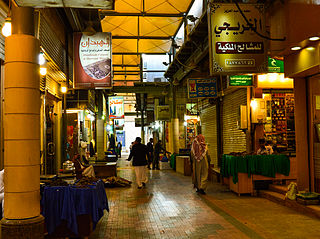
Old Riyadh is an umbrella term used for a loosely defined region that primarily lies in the southern portion of modern-day Riyadh, Saudi Arabia, encompassing neighborhoods and settlements that emerged from ruins of Hajr al-Yamamah in late 16th century, the erstwhile walled town enclosed within the defensive fortifications and its immediate vicinity prior to its demolition in 1950, and villages and former towns located along the outskirts of Riyadh that got incorporated into the metropolis following multiple phases of expansion and modernization between the 1950s and 1970s. To some extent, neighborhoods excluded during Riyadh's rapid urbanization during the same period are also categorized as part of old districts, with most of them situated in the modern downtown.

The Declaration of theUnification of Saudi Arabia was officially announced by Prince Faisal bin Abdulaziz, the Viceroy of Hejaz on behalf of King Abdulaziz ibn Saud on September 23, 1932, at 9:00 am from al-Hamidiyah Palace in Mecca. Faisal read out the Royal Decree No. 2716 issued by Abdulaziz ibn Saud on September 18, 1932, that renamed the Kingdom of Hejaz and Nejd and its annexes as the Kingdom of Saudi Arabia.
Dahham ibn Dawwas ibn Abdullah al-Shalaan was an 18th-century Arab tribal from Mutayr tribe and political leader from Manfuhah who ruled as the first chieftain of the walled town of Riyadh from 1745 until 1773. He previously reigned as the regent for Ibn Zaid ibn Musa between 1740 and 1745 and is widely credited with laying the foundations of Riyadh, the-present day capital of Saudi Arabia, by constructing a mudbrick palace and erecting a defensive wall to ward-off invaders and intruders. He was one of the earliest political and military opponents to the House of Saud and the nascent Wahhabi movement, resulting in a conflict with Diriyah that lasted for almost 27 years. His overall strategic failure and miscalculated decisions throughout the course of the conflict led to his eventual overthrow at the hands of the First Saudi State, making his name synonymous with acts of foolishness and ineptitude in the Najd.
Al-Zulfi is the most populous city in the Al-Zulfi Governorate, which encompasses the Al-Zulfi Emirate of Riyadh Province within the Kingdom of Saudi Arabia. It is situated in the center of the governorate, on the periphery of Shuaib Samnan, between the Tuwaiq Mountains and the sand dunes of Nafud al-Thuwairat. The city's population is 68,317.
